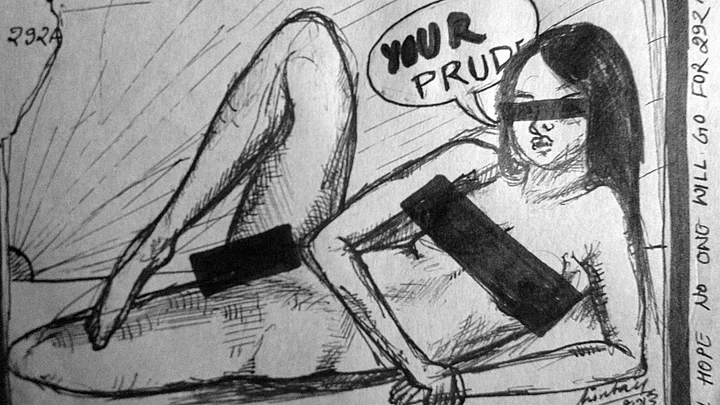Trainees at The Illustrated Weekly of India, now defunct, would be advised by Khushwant Singh, “You should be obscene, not heard.” Pun pundit, he certainly wasn’t, but that would send us into a titter, pun again unintended.
Khushwant Singh’s pitch was, “Bachcha log, don’t be afraid to write what you want to about sex.” Stinky-poo words like ‘farts’ and ‘crap’ were okay too, we were exhorted to be cool about the uncool.
So why am I bringing up those lost days of the mid-1970s today? Perhaps because impolite words, sensual visuals and colloquialisms, still raise hackles although we’re well into a new millennium. Moral policing has intensified, bans are as common as those dengue-spewing mosquitoes. And you’d better think thrice, before venturing into the politically incorrect.
Which brings me to the globally feted artist, Chintan Upadhyay, who has shifted base since the last four years from Mumbai to Sheikh Serai in New Delhi. And at this very moment, the 43-year-old artist is readying a show for Baroda, Delhi and Mumbai, tentatively titled Gandi Baat: a collection of sketches and drawings on altering morals and foibles, contextualising the sounds and sights encountered among the youth of Delhi, by day and past midnight.
The images are quirky, witty, employ ungrammatical patois, besides saluting Dilli girls and women, who’re fed up and won’t take street side chauvinism any more. Be it those infamous gropes in crowded buses or eve-teasing catcalls, the artworks assert that this shameful behaviour must end in the nation’s capital where rapes can occur even in broad daylight.
Chintan Upadhyay’s intentions to spread awareness about the war between the genders is well-intentioned, but aren’t some of the provocative Gandi Baat artworks likely to spark a controversy? To that, his response is, “Not at all. The images are about how people are becoming more loud and aggressive even on TV talk shows. A backlash to such aggression is inevitable.”
The Interview
Alright, then, let’s take this further, let’s Q and A.
Er, do you mean the hectoring Arnab Goswami?
It’s okay for journalists to get aggressive, I suppose. That’s the style Arnab Goswami has adopted. My focus is on the rise of aggression in Delhi’s everyday life. It is different from Mumbai’s culture which is extremely Bollywoodish, almost cartoonish. In Delhi, the aggression stems from politics, of boasting about connections in high places, of talking big to convey how powerful one is, of yelling out loud, “ Ther tu, Teri toh band bajaa doonga” (“You wait. I’ll destroy you”).
Also I’ve noticed that men in Delhi even if they are senior citizens, tend to look at fair-skinned foreign women as Russians, and you know what that means.
You mean foreign “footloose”, for want of a better word?
More than footloose actually. In fact, a young French woman was asked, “Aren’t you Russian?” She knew what that meant and was quite enraged by the implication.
Since it would be sub-judice to talk about the charge levelled against you by your wife, Hema, in the course of divorce proceeding, I would only ask you, has that affected your art at all?
That did affect me a lot as a person but not as an artist. I didn’t get into self-censorship in my work at all. The charge was that I had made some obscene drawings in my room. In any case, these so-called obscene drawings were in my personal space. Some artists did comment that I shouldn’t have made those wall drawings but without even seeing them. It’s easy to describe any image as obscene. But when I was at the art school in Baroda, there would be a class for Nude Studies, we’d study the anatomy of models. Would you call that obscene?
And when the cops came to arrest me at my house, they saw a painting in which a policeman’s face resembled a breast. To that, the cop suggested, “Why don’t you make cops look like gods instead?” I found that very amusing. I’ve never been able to look at that cop painting with a straight face again.
Why do artists run into trouble about sexual imagery?
Because artists are soft targets. When you don’t have anyone else to attack, just protest against the nudes of Akbar Padamesee like they once did. Or disrespect was found in the representations of M F Husain. Sanjeev Khandekar’s Tits, Clits and Elephant Dicks came under flak although he was mirroring consumerist trends. Surendran Nair’s painting showing a naked man with strapped-on wings atop the Ashoka column, was removed from the National Gallery of Modern Art.
So what’s the solution for an artist to gain freedom of expression?
Much, much more tolerance and diminished aggression.
(The writer is a film critic, filmmaker, theatre director and a weekend painter)
